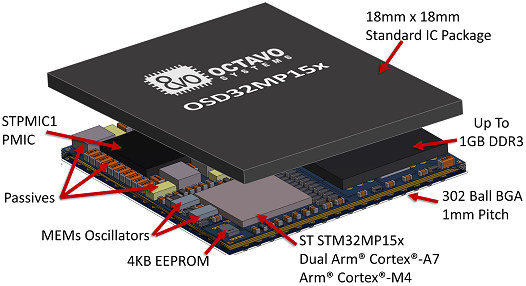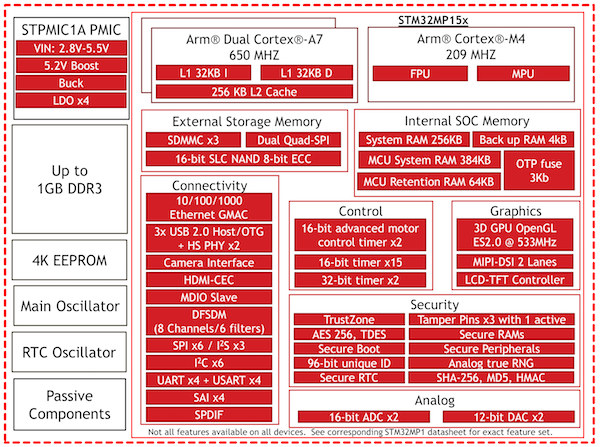STMicro STM32MP1 is one of the most interesting microprocessor recently announced, as it should allow a relatively easy upgrade path for projects based on the traditional STM32 Cortex-M4 microcontrollers, thanks to backward compatibility, and the extra one or two Arm Cortex-A7 cores enabling Linux support.
We’ve already seen several upcoming evaluation and development boards based on STM32MP157 processor including STMicro’s own discovery kits and evaluation platform, as well as Arrow Electronics Avenger96 board fitted with a tiny 29x29mm SoM. But I suspect we could see even more compact designs soon, as Octavo Systems has now unveiled OSD32MP15x system-in-package with STM32MP15x MPU, up to 1GB RAM, 4K EEPROM, STPMIC1 power management IC, two oscillators, and over 100 passive components all brought together into a 18x18mm package.
 Octavo Systems OSD32MP15x system-in-package main components and specifications:
Octavo Systems OSD32MP15x system-in-package main components and specifications:
- MPU (MicroProcessor Unit) – STMicroelectronics STM32MP15x with Dual Arm Cortex-A7 @ 650MHz, Arm Cortex-M4 real-time core @ 209 MHz, Vivante 3D GPU
- System Memory -Up to 1GB DDR3L Memory
- Storage – 4KB Non-Volatile EEPROM
- I/Os – Access to all signals of the STM32MP1 TFBGA 361 package
- Misc – 2x Low power MEMS Oscillators, over 100 Passives
- Power Management
- STPMIC1 Power Management IC (PMIC) with single 2.8V to 5.5V supply voltage input, 5.2V integrated boost; 4x buck LDO’s, 2x power switches
- Power In – AC Adapter, USB, or Single cell (1S) Li-Ion/Li-Po Battery
- Power Out – 1.8V, 3.3V and SYS (Switched VIN)
- Selectable AM335x I/O Voltage: 1.8V or 3.3V
- Package – 302 Ball BGA (18mm x 18mm), 16 x 16 grid, 1mm Pitch
- Temperature Range – 0° to 85°C or -40° to 85°C

There’s no OSD32MP15x development board just yet, but the company is working on it, and I would not surprised if we eventually get a board similar to PocketBeagle, but featuring STMicro based OSD32MP15x SiP instead of the Texas Instruments Sitara powered OSD3358-SM SiP from the company. As a side note OSD32MP15x is even smaller than OSD3358-SM SiP (18x18mm vs 21×21 mm).
Two parts will become available in Q3 (Samples) and Q4 (mass production), namely OSD32MP157C-512M-BAA and OSD32MP157C-512M-IAA, both with STM32MP157C MPU and 512MB DDR3L, but differing by their temperature range, respectively 0° to 85°C and -40° to 85°C. Further information, including the datasheet and Octavo EAGLE library, can be found in the product page.
Thanks to jealcuna for the tip.

Jean-Luc started CNX Software in 2010 as a part-time endeavor, before quitting his job as a software engineering manager, and starting to write daily news, and reviews full time later in 2011.
Support CNX Software! Donate via cryptocurrencies, become a Patron on Patreon, or purchase goods on Amazon or Aliexpress




